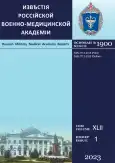Some features of the immune system response in the new coronavirus infection COVID-19
- Authors: Protasov O.V.1, Bolekhan A.V.1, Arzhavkina L.H.1,2, Bogdanova E.G.1, Chugunov A.A.1
-
Affiliations:
- Military Medical Academy
- I.I. Mechnikov North-West State Medical University
- Issue: Vol 42, No 1 (2023)
- Pages: 29-36
- Section: Original articles
- URL: https://bakhtiniada.ru/RMMArep/article/view/264775
- DOI: https://doi.org/10.17816/rmmar108628
- ID: 264775
Cite item
Abstract
AIM: to study the cytokine link of immunity in patients with the new coronavirus infection COVID-19 and the possibility of using these data to predict the risk of lung tissue damage.
MATERIALS AND METHODS: Patients with diagnosed new coronavirus infection COVID-19 were divided into 4 groups depending on the severity of the disease: 1 — asymptomatic patients; 2 — patients with lung tissue damage in the amount of 25%; 3 — patients with lung tissue damage 50%; 4 — patients with lung tissue damage 75% (according to the results computed tomography). Immunological studies were performed upon admission to the clinic, then after 7 days and before discharge. The concentration of cytokines in blood serum was studied by the method of solid-phase enzyme immunoassay using kits manufactured by Vector Best.
RESULTS: In all groups, a low content of proinflammatory cytokines was found: tumor necrosis factor and interferon-γ, interleukin-1, interleukin-2. The median level of interleukin-6 in all groups during the entire follow-up period was within the normal range, however, in some patients there was a multiple excess of its concentration. In groups with 50% and 75% lung tissue damage, an increase in the concentration of interleukin-8 was shown. Statistically significant differences were noted only for the level of interleukin-8 between the group with an asymptomatic form of infection and the CT-2 and CT-3 groups. It was found that the concentration of interleukin-1 below 3.58 pg/ml is a significant risk factor for severe disease. In all groups of subjects, low levels of interleukin-4 and interleukin-10 were noted, while there was no significant difference between the groups. Positive correlations were revealed between the degree of lung tissue damage and the level of interleukins 6, 2 and 8. Negative correlations were established between the degree of lung tissue damage and the content of interleukin-1.
CONCLUSION: There was no significant activation of the cytokine link of adaptive antiviral immunity in the examined contingent. Serum cytokine levels were within normal values and had no significant intergroup differences. An increase in IL-8 in groups with clinically pronounced signs of infection indicates the activation of indicators characterizing innate immunity.
Full Text
##article.viewOnOriginalSite##About the authors
Oleg V. Protasov
Military Medical Academy
Author for correspondence.
Email: olegprotasov025@gmail.com
SPIN-code: 8452-9089
Scopus Author ID: 881632
M.D., Ph.D. (Medicine), Lieutenant Colonel of Medical Service, Senior Researcher of the Research Laboratory (Military Therapy) Scientific Department (experimental medicine) of the Research Center
Russian Federation, Saint PetersburgAnna V. Bolekhan
Military Medical Academy
Email: a.bolekhan@gmail.com
SPIN-code: 5182-8600
Scopus Author ID: 572884
Ph.D. (Biology), Senior Researcher of the Research Laboratory (Medicinal and Environmental Toxicology) Scientific Department (experimental medicine) of the Research Center
Russian Federation, Saint PetersburgLayla H. Arzhavkina
Military Medical Academy; I.I. Mechnikov North-West State Medical University
Email: vanadzor_@rambler.ru
ORCID iD: 0000-0001-5198-874X
SPIN-code: 8359-4200
Scopus Author ID: 881269
Ph.D. (Biology), Senior Researcher of the Research Laboratory (Military Therapy) Scientific Department (experimental medicine) of the Research Center
Russian Federation, Saint Petersburg; Saint PetersburgElena G. Bogdanova
Military Medical Academy
Email: belena-san@bk.ru
SPIN-code: 7726-8614
Scopus Author ID: 881510
Ph. D. (Biology), Researcher of the Research Laboratory (Military Therapy) Scientific Department (experimental medicine) of the Research Center
Russian Federation, Saint PetersburgAlexandr A. Chugunov
Military Medical Academy
Email: alexandrchugun@yandex.ru
ORCID iD: 0000-0002-2532-6133
SPIN-code: 3839-7619
Scopus Author ID: 1077745
adjunct at the 1st Department of Internal Medicine Postgraduate Training
Russian Federation, Saint PetersburgReferences
- Azarov II, Ovchinnikov DV, Kuzin AA, et al. Assessment of post-vaccination collective immunity against new coronavirus infection (COVID-19) among servicemen of the Armed Forces of the Russian Federation. Bulletin of the Russian Military Medical Academy. 2022;24(2):267–276. (In Russ.)
- Ivchenko EV, Kotiv BN, Ovchinnikov DV, Butsenko SA. Results of the work of the Research Institute of Problems of new coronavirus infection of the Military Medical Academy for 2020–2021. Bulletin of the Russian Military Medical Academy. 2021;23(4):93–104. (In Russ.)
- Kryukov EV, Trishkin DV, Salukhov VV, Ivchenko EV. Experience of military medicine in the fight against a new coronavirus infection. Bulletin of the Russian Academy of Sciences. 2022;92(7):699–706. (In Russ.)
- Kryukov EV, Trishkin DV, Ivanov AM, et al. Epidemiological study of collective immunity against a new coronavirus infection among different groups of military personnel. Bulletin of the Russian Academy of Medical Sciences. 2021;76(6):661–668. (In Russ.)
- Minnullin TI, Stepanov AV, Chepur SV, et al. Immunological aspects of coronavirus SARS-COV-2 infection. Bulletin of the Russian Military Medical Academy. 2021;2(74):187–198. (In Russ.)
- Chen N, Zhou M, Dong X, et al. Epidemiological and clinical characteristics of 99 cases of 2019 novel coronavirus pneumonia in Wuhan, China: a descriptive study. Lancet. 2020;395(10223):507–513. doi: 10.1016/S0140-6736(20)30211-7
- Huang C, Wang Y, Li X, et al. Clinical features of patients infected with 2019 novel coronavirus in Wuhan, China. Lancet. 2020;395(10223):497–506. doi: 10.1016/S0140-6736(20)30183-5
- Bilichenko TN. Risk factors, immunological mechanisms and biological markers of severe COVID-19 (research review). Medical Review. 2021;(5):237–244. (In Russ.)
- Channappanavar R, Fehr A, Vijay R, et al. Dysregulated type I interferon and inflammatory monocyte-macrophage responses cause lethal pneumonia in SARS-CoV-infected mice. Cell Host Microbe. 2016;19(2):181–193. doi: 10.1016/j.chom.2016.01.007
- Huang KJ, Su IJ, Theron M, et al. An interferon-gamma-related cytokine storm in SARS patients. J Med Virol. 2005;75(2):185–194. doi: 10.1002/jmv.20255
- Xu Z, Shi L, Wang Y, et al. Pathological findings of COVID-19 associated with acute respiratory distress syndrome. Lancet Respir. Med. 2020;8(4):420–422. doi: 10.1016/S2213-2600(20)30076-X
- Qin C, Zhou L, Hu Z, et al. Dysregulation of immune response in patients with COVID-19 in Wuhan, China. Clin Infect Dis. 2020;71(15):762–768. doi: 10.1093/cid/ciaa248
Supplementary files







